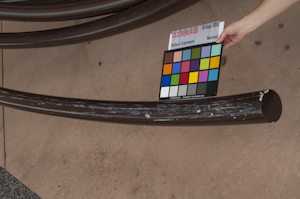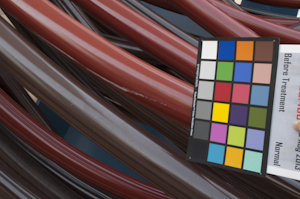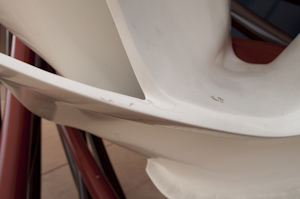In August, a conservation project on the sculpture Big Sweep was completed. Big Sweep was designed by artists Coosje van Bruggen and Claes Oldenburg, who worked closely with fabricator Carlson & Co. to realize the sculpture in its final form.
Conservation included cleaning the surfaces and repainting parts of the sculpture to repair damages caused by people skateboarding and climbing on the sculpture. Though the actual work on the sculpture only took a few days, planning for the project started months earlier to formulate a treatment approach, find the right specialist to carry out the work, and plan every step of the process to make it run smoothly and safely. I was the lead conservator on the project.
This kind of project may not be what first comes to mind when you think of art conservation. But art conservators work on all kinds of cultural materials from drawings, easel paintings, and porcelain vases to outdoor sculptures, buildings, and archaeological sites. Though conservators do hands-on work themselves in many instances, sometimes they function more as project managers, working with curators and other colleagues to make decisions about a project and delegating the hands-on work to others with highly specialized skills. Conservation work encompasses much more than the craft skills needed to make damages to artworks disappear. Most important, conservation takes an ethical approach to the way we preserve, maintain, handle, and display artworks and other cultural materials.
In most instances, when carrying out a physical intervention on an artwork, conservators strive to preserve the original materials and to do nothing that would permanently alter those materials. However, works located outdoors are sometimes an exception, as the sun, wind, and temperature and humidity extremes can cause those original materials to degrade very quickly. Human interaction can be another factor that contributes to damage and deterioration, as in the case of Big Sweep. It is generally accepted by conservators that painted outdoor sculptures will have to be repainted periodically in order to preserve their structural integrity and maintain their intended appearance. Still, any repainting project must be carried out with great care to respect the authenticity of the artwork and the original appearance of the sculpture as intended by the artist.
This conservation project started with an overall evaluation of the condition of the sculpture with William Morrow, Polly and Mark Addison Associate Curator of Contemporary Art. Big Sweep is constructed of stainless steel, aluminum, and fiberglass, painted with acrylic-polyurethane paint, which is very similar to automotive paint. Examination revealed that, overall, after seven years, the sculpture was still in very good condition. Comparisons of the paint on the sculpture with paint samples prepared at the time the sculpture was made and kept inside in a controlled environment revealed that the paint colors had not faded or altered.
The damage to the sculpture was mostly limited to a height of eight feet and below and consisted of scuffs, scratches, abrasions, and some deep chips.
Full repainting of the sculpture will inevitably be necessary at some point, which will require disassembling and removing the sculpture to a workshop, as well as many hours of labor. At this time, we agreed that we could greatly improve the appearance of the sculpture by working on-site to repaint only a few areas. This would allow us more time to plan and gather resources for full repainting, while still addressing the damage.
In part two of this blog post I go into more details about the actual process of cleaning up and repainting.
Image credit: Claes Oldenburg and Coosje van Bruggen, Big Sweep, 1999-2006. During conservation treatment when most of the sculpture was masked off. ©Claes Oldenburg and Coosje van Bruggen. Denver Art Museum: Purchased in honor of Tom and Noël Congdon with funds from 1998 Collectors’ Choice, with support from the estate of Richard H. Bosworth, Cyprus Amax Minerals Company, Charles and Diane Gallagher, Jerry Gart Family Foundation, Frederic C. and Jane Hamilton, Hines, Jan and Frederick R. Mayer, Paul and Lilly Merage, Larry and Carol Mizel, Ken and Judy Robins, Titanium Metals Corporation, Carl and Lisa Williams, Ginny Williams, and an anonymous donor.
Additional funding was provided by Mark and Polly Addison, Joan Anderman, Bruce and Marcy Benson, Nancy Lake Benson, Jim and Janice Campbell, Howard and Beulah Cherne, Steven and Robin Chotin, Tom and Noël Congdon, Peter and Philae Dominick, Suzanne Farver, Leonard and Kay Gemmill, Dorothy Strear Goodstein, Robert and Diane Greenlee, Heidi Hamilton, Mark and Diana Hayden, Harley and Lorraine Higbie, A. Barry and Arlene Hirschfeld, Grafton and Sue Jhung, Glenn Jones and Diane Eddolls, Mariner and Megan Kemper, Bill and Alma Kurtz, Ed and Margaret Anne Leede, Susan and John W. Madden III, Caroline Morgan, Trygve and Vicki Myhren, NBT Foundation, Denny and Judy O’Brien, Andrea Singer Pollack, and an anonymous donor, 1998.496.




